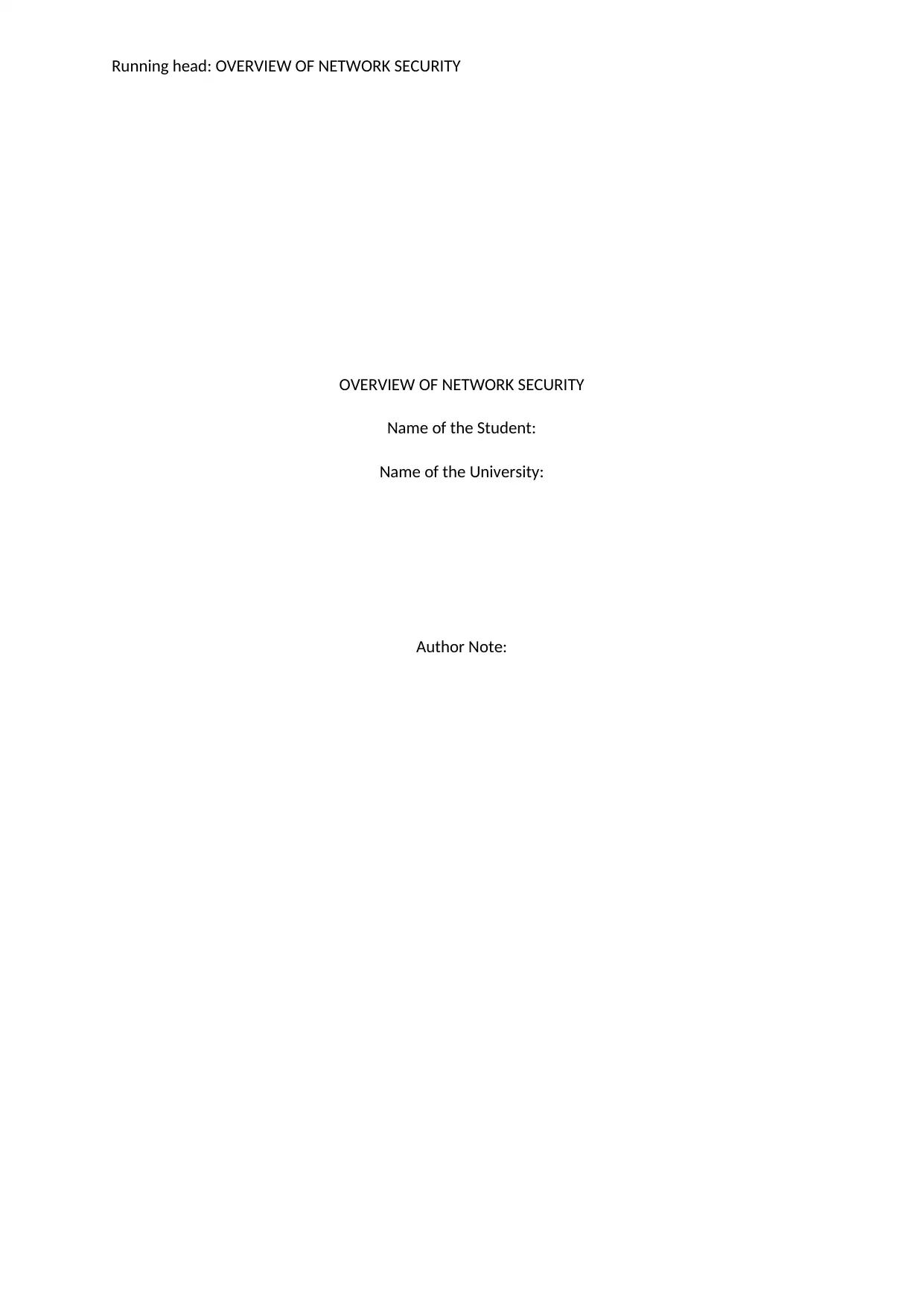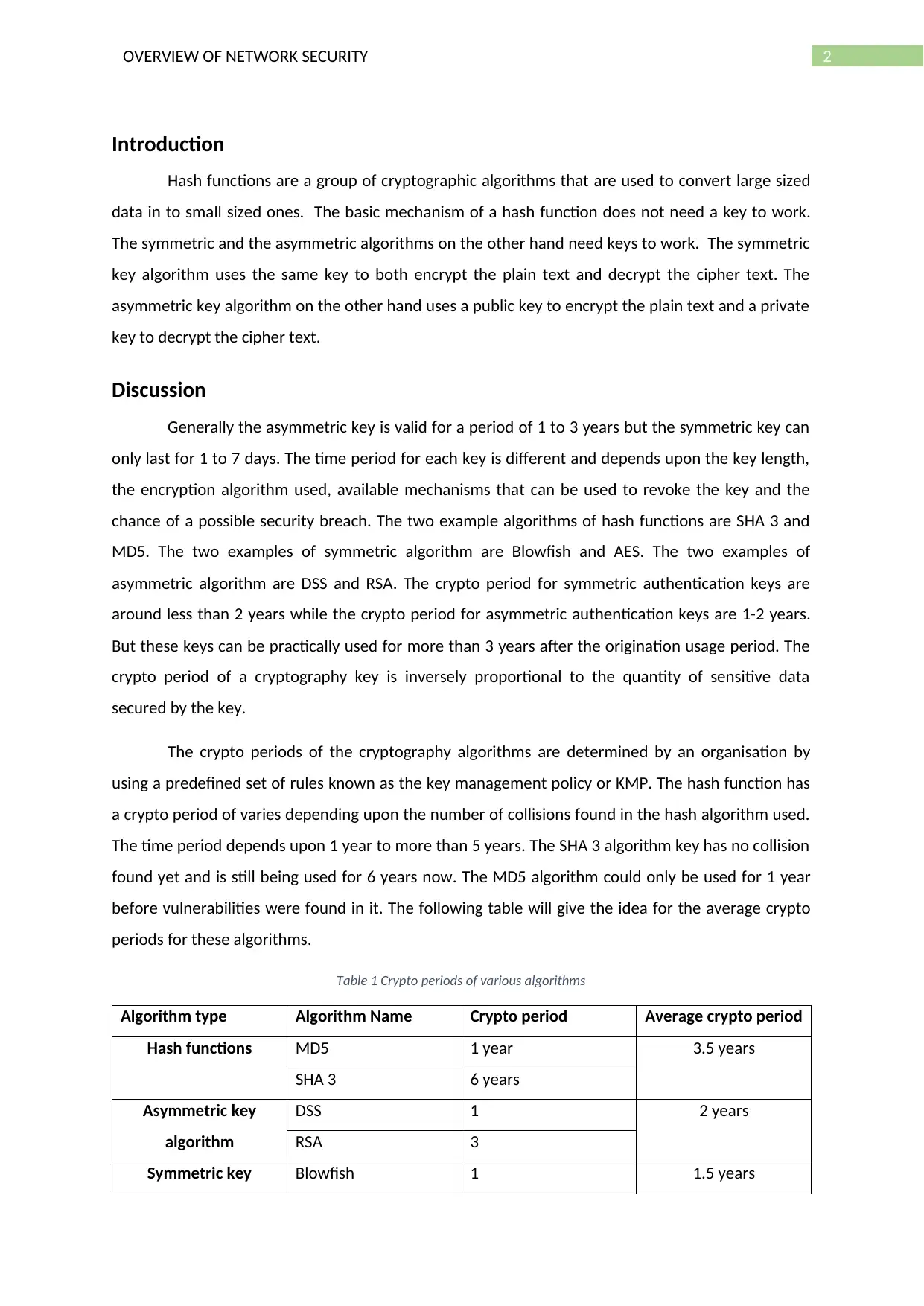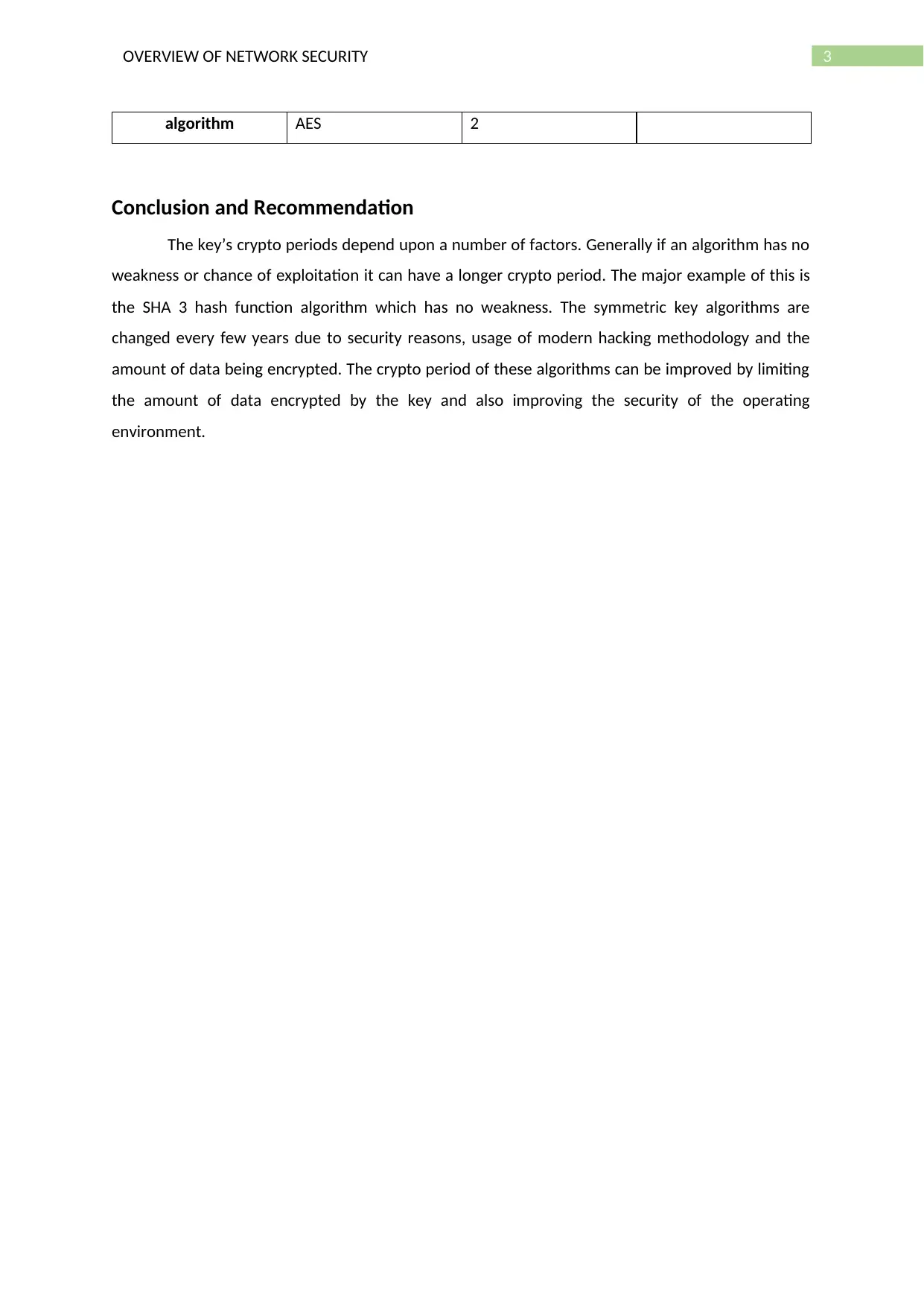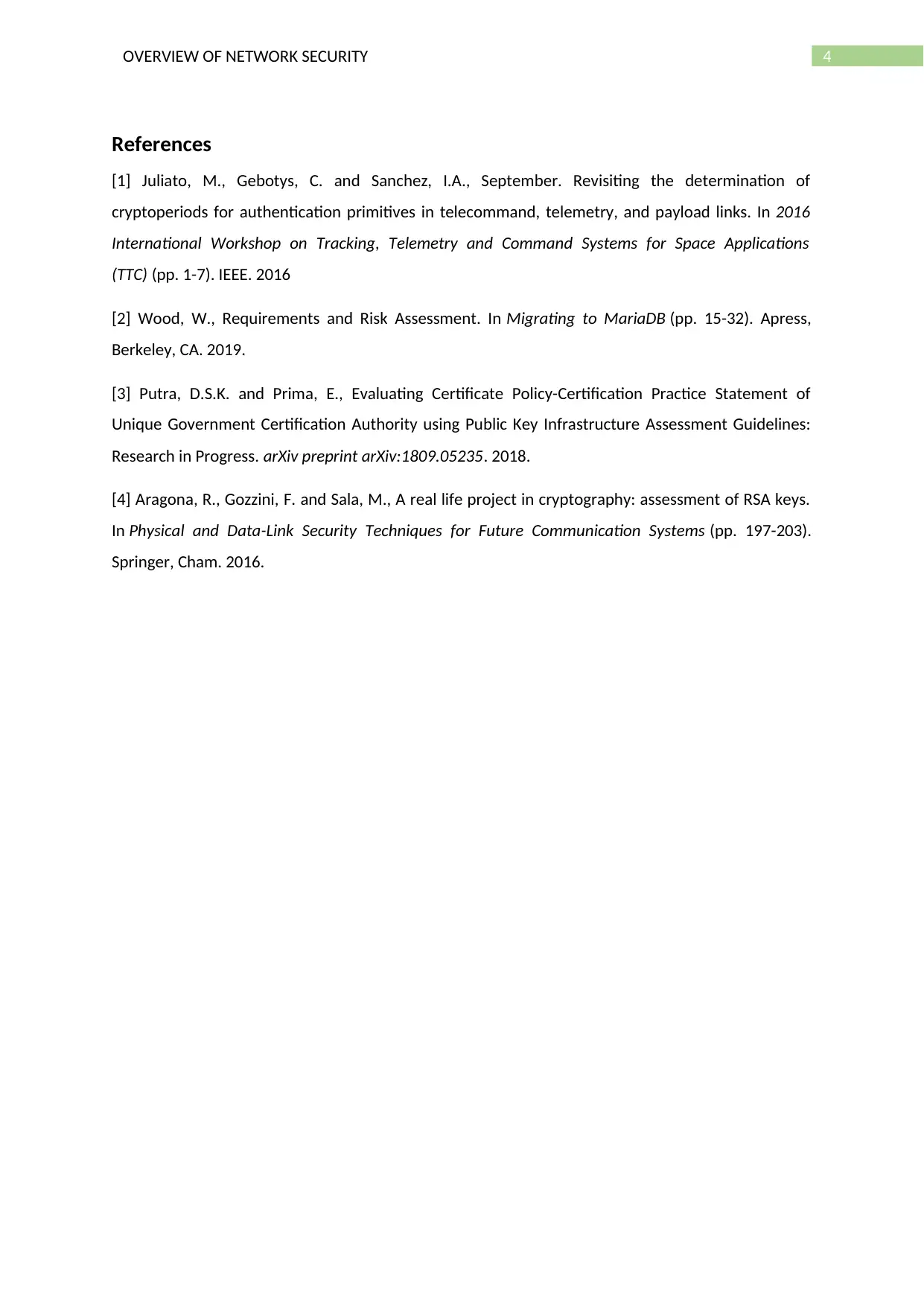Postgraduate Report: Overview of Network Security and Cryptoperiods
VerifiedAdded on 2023/03/21
|5
|775
|62
Report
AI Summary
This report provides an overview of network security, focusing on the concept of cryptoperiods, which is the duration for which a cryptographic key is authorized for use. It discusses hash functions (SHA 3, MD5) and symmetric (Blowfish, AES) and asymmetric (DSS, RSA) key algorithms. The report highlights the factors influencing cryptoperiods, such as key length, algorithm type, and potential security vulnerabilities. It includes a table summarizing the average crypto periods for different algorithms. The report concludes with recommendations for improving crypto periods by limiting the amount of data encrypted and enhancing the security of the operating environment. References are provided in IEEE style. This report was prepared for an internship application at Royal Consulting Services (RCS).

Running head: OVERVIEW OF NETWORK SECURITY
OVERVIEW OF NETWORK SECURITY
Name of the Student:
Name of the University:
Author Note:
OVERVIEW OF NETWORK SECURITY
Name of the Student:
Name of the University:
Author Note:
Paraphrase This Document
Need a fresh take? Get an instant paraphrase of this document with our AI Paraphraser

1OVERVIEW OF NETWORK SECURITY
Table of Contents
Introduction...........................................................................................................................................2
Discussion..............................................................................................................................................2
Conclusion and Recommendation.........................................................................................................3
References.............................................................................................................................................4
Table of Contents
Introduction...........................................................................................................................................2
Discussion..............................................................................................................................................2
Conclusion and Recommendation.........................................................................................................3
References.............................................................................................................................................4

2OVERVIEW OF NETWORK SECURITY
Introduction
Hash functions are a group of cryptographic algorithms that are used to convert large sized
data in to small sized ones. The basic mechanism of a hash function does not need a key to work.
The symmetric and the asymmetric algorithms on the other hand need keys to work. The symmetric
key algorithm uses the same key to both encrypt the plain text and decrypt the cipher text. The
asymmetric key algorithm on the other hand uses a public key to encrypt the plain text and a private
key to decrypt the cipher text.
Discussion
Generally the asymmetric key is valid for a period of 1 to 3 years but the symmetric key can
only last for 1 to 7 days. The time period for each key is different and depends upon the key length,
the encryption algorithm used, available mechanisms that can be used to revoke the key and the
chance of a possible security breach. The two example algorithms of hash functions are SHA 3 and
MD5. The two examples of symmetric algorithm are Blowfish and AES. The two examples of
asymmetric algorithm are DSS and RSA. The crypto period for symmetric authentication keys are
around less than 2 years while the crypto period for asymmetric authentication keys are 1-2 years.
But these keys can be practically used for more than 3 years after the origination usage period. The
crypto period of a cryptography key is inversely proportional to the quantity of sensitive data
secured by the key.
The crypto periods of the cryptography algorithms are determined by an organisation by
using a predefined set of rules known as the key management policy or KMP. The hash function has
a crypto period of varies depending upon the number of collisions found in the hash algorithm used.
The time period depends upon 1 year to more than 5 years. The SHA 3 algorithm key has no collision
found yet and is still being used for 6 years now. The MD5 algorithm could only be used for 1 year
before vulnerabilities were found in it. The following table will give the idea for the average crypto
periods for these algorithms.
Table 1 Crypto periods of various algorithms
Algorithm type Algorithm Name Crypto period Average crypto period
Hash functions MD5 1 year 3.5 years
SHA 3 6 years
Asymmetric key
algorithm
DSS 1 2 years
RSA 3
Symmetric key Blowfish 1 1.5 years
Introduction
Hash functions are a group of cryptographic algorithms that are used to convert large sized
data in to small sized ones. The basic mechanism of a hash function does not need a key to work.
The symmetric and the asymmetric algorithms on the other hand need keys to work. The symmetric
key algorithm uses the same key to both encrypt the plain text and decrypt the cipher text. The
asymmetric key algorithm on the other hand uses a public key to encrypt the plain text and a private
key to decrypt the cipher text.
Discussion
Generally the asymmetric key is valid for a period of 1 to 3 years but the symmetric key can
only last for 1 to 7 days. The time period for each key is different and depends upon the key length,
the encryption algorithm used, available mechanisms that can be used to revoke the key and the
chance of a possible security breach. The two example algorithms of hash functions are SHA 3 and
MD5. The two examples of symmetric algorithm are Blowfish and AES. The two examples of
asymmetric algorithm are DSS and RSA. The crypto period for symmetric authentication keys are
around less than 2 years while the crypto period for asymmetric authentication keys are 1-2 years.
But these keys can be practically used for more than 3 years after the origination usage period. The
crypto period of a cryptography key is inversely proportional to the quantity of sensitive data
secured by the key.
The crypto periods of the cryptography algorithms are determined by an organisation by
using a predefined set of rules known as the key management policy or KMP. The hash function has
a crypto period of varies depending upon the number of collisions found in the hash algorithm used.
The time period depends upon 1 year to more than 5 years. The SHA 3 algorithm key has no collision
found yet and is still being used for 6 years now. The MD5 algorithm could only be used for 1 year
before vulnerabilities were found in it. The following table will give the idea for the average crypto
periods for these algorithms.
Table 1 Crypto periods of various algorithms
Algorithm type Algorithm Name Crypto period Average crypto period
Hash functions MD5 1 year 3.5 years
SHA 3 6 years
Asymmetric key
algorithm
DSS 1 2 years
RSA 3
Symmetric key Blowfish 1 1.5 years
⊘ This is a preview!⊘
Do you want full access?
Subscribe today to unlock all pages.

Trusted by 1+ million students worldwide

3OVERVIEW OF NETWORK SECURITY
algorithm AES 2
Conclusion and Recommendation
The key’s crypto periods depend upon a number of factors. Generally if an algorithm has no
weakness or chance of exploitation it can have a longer crypto period. The major example of this is
the SHA 3 hash function algorithm which has no weakness. The symmetric key algorithms are
changed every few years due to security reasons, usage of modern hacking methodology and the
amount of data being encrypted. The crypto period of these algorithms can be improved by limiting
the amount of data encrypted by the key and also improving the security of the operating
environment.
algorithm AES 2
Conclusion and Recommendation
The key’s crypto periods depend upon a number of factors. Generally if an algorithm has no
weakness or chance of exploitation it can have a longer crypto period. The major example of this is
the SHA 3 hash function algorithm which has no weakness. The symmetric key algorithms are
changed every few years due to security reasons, usage of modern hacking methodology and the
amount of data being encrypted. The crypto period of these algorithms can be improved by limiting
the amount of data encrypted by the key and also improving the security of the operating
environment.
Paraphrase This Document
Need a fresh take? Get an instant paraphrase of this document with our AI Paraphraser

4OVERVIEW OF NETWORK SECURITY
References
[1] Juliato, M., Gebotys, C. and Sanchez, I.A., September. Revisiting the determination of
cryptoperiods for authentication primitives in telecommand, telemetry, and payload links. In 2016
International Workshop on Tracking, Telemetry and Command Systems for Space Applications
(TTC) (pp. 1-7). IEEE. 2016
[2] Wood, W., Requirements and Risk Assessment. In Migrating to MariaDB (pp. 15-32). Apress,
Berkeley, CA. 2019.
[3] Putra, D.S.K. and Prima, E., Evaluating Certificate Policy-Certification Practice Statement of
Unique Government Certification Authority using Public Key Infrastructure Assessment Guidelines:
Research in Progress. arXiv preprint arXiv:1809.05235. 2018.
[4] Aragona, R., Gozzini, F. and Sala, M., A real life project in cryptography: assessment of RSA keys.
In Physical and Data-Link Security Techniques for Future Communication Systems (pp. 197-203).
Springer, Cham. 2016.
References
[1] Juliato, M., Gebotys, C. and Sanchez, I.A., September. Revisiting the determination of
cryptoperiods for authentication primitives in telecommand, telemetry, and payload links. In 2016
International Workshop on Tracking, Telemetry and Command Systems for Space Applications
(TTC) (pp. 1-7). IEEE. 2016
[2] Wood, W., Requirements and Risk Assessment. In Migrating to MariaDB (pp. 15-32). Apress,
Berkeley, CA. 2019.
[3] Putra, D.S.K. and Prima, E., Evaluating Certificate Policy-Certification Practice Statement of
Unique Government Certification Authority using Public Key Infrastructure Assessment Guidelines:
Research in Progress. arXiv preprint arXiv:1809.05235. 2018.
[4] Aragona, R., Gozzini, F. and Sala, M., A real life project in cryptography: assessment of RSA keys.
In Physical and Data-Link Security Techniques for Future Communication Systems (pp. 197-203).
Springer, Cham. 2016.
1 out of 5
Related Documents
Your All-in-One AI-Powered Toolkit for Academic Success.
+13062052269
info@desklib.com
Available 24*7 on WhatsApp / Email
![[object Object]](/_next/static/media/star-bottom.7253800d.svg)
Unlock your academic potential
Copyright © 2020–2025 A2Z Services. All Rights Reserved. Developed and managed by ZUCOL.




